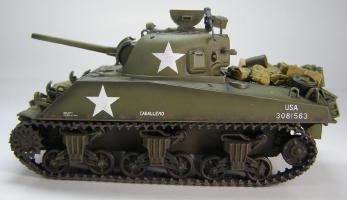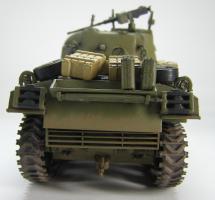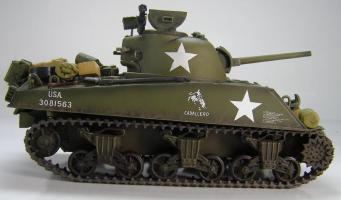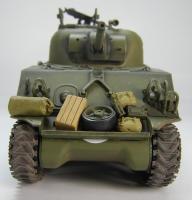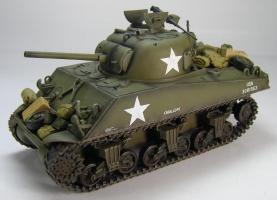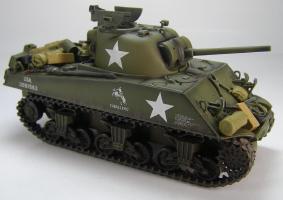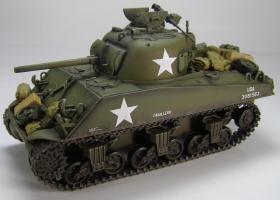Hobby Master Archive
Ground Power 1/48
Sherman
Sherman M4A3 75mm caballero 6th Armored Division 69th Tank Battalion
Hobby Master 1/48 Ground Power Series HG1001 Sherman M4A3 75MM, “Caballero” 6th Armored Division, 69th Tank Battalion
History of the M4A3 (75mm) The prototype of the M4 was designated the T-6 and appeared in September 1941. This medium tank would go on to be one of the most important pieces of armor in WW II. Its production number of approximately 55,000 of all versions was only surpassed by the Soviet T-34 57,000 of all its versions. About 44,000 were armed with the 75mm Gun M3, with 6,465 76mm Gun M1, and 4,180 armed with the 105mm Howitzer M4. At production start up 1,000 units a month came off the assembly line with that number increasing to 2,000 per month when all 11 plants were up and running. These medium tanks played a major role in Allied victories in every TO around the These medium tanks played a major role in Allied victories in every TO around the world during WW II. With the advent of the M4 in 1941 came a number of world during WW II. With the advent of the M4 in 1941 came a number of improvements over the M3 series that this new tank was replacing. Instead of the fixed gun locations on the M3 a 75mm gun was relocated to the turret of the M4 and this allowed for 360 degree coverage. Also the elevation and depression of the new gun location was increased giving total combat area coverage. The M4A1 introduced a cast hull where the previous models had welded hulls. All versions of the M4 had cast turrets and sat on a ball bearing race and was recessed to protect the crew. It was realized within the first year that the early production M4s were not combat capable against their opponents. In 1943 a firm commitment to “win the war” was made and the Sherman would be the vehicle to use. This meant that the tank would have to undergo some major changes. The late production version of the 75mm first rolled out of the factories in February 1944 with an angled front hull and 63.5mm armored plate. The Sherman went through various gun and armour upgrades throughout WWII as a result of combat experience. The 75mm (M2 L/31) cannon of the early M4’s was upgraded to the higher muzzle velocity 75mm (M3 L/40). To the turret, a cupola for the commander and hatch for the loader were added. This version was also equipped with wet ammo stowage bins, which helped prevent internal fires and explosions. This occurrence was common knowledge as the Americans’ nickname for the Sherman was the ZIPPO, after the lighter (lights first time, every time), while the Germans called it the TOMMY COOKER or “Ronsons” Late models had improved cupola, a loaders hatch, and wet storage for ammunition. The ammunition was stored in water protected racks below the turret instead of in the sponsons. Ten boxes on the hull floor held 100 rounds and needed 37.1 gallons of water. a further gallon was needed to protect the four ready rounds. The water contained ethylene glycol to prevent freezing and a corrosion inhibiter known as “Ammudamp”. The Fisher Tank Arsenal manufactured “wet” storage 76mm and 75mm armed models. In 1944 the Horizontal Volute Spring Suspension (HVSS) with a wide center guide track was phased into production this enhanced mobility over rough terrain and enabled the Sherman to keep up with the once much faster Panthers. Units produced with HVSS suspension were called “Easy Eights”. The earlier VVSS ( Vertical Volute Spring Suspension) had a much narrower track that made it difficult for the Sherman to maneuver on soft ground and mud. The VVSS had to use return rollers to prevent the track from jumping off the drive wheels or snagging. HVSS springs lie flat on the bogie assembly and are fitted in opposed pairs. Its most obvious features are dual wheels with a shock absorber above the cylindrical spring units. Over 44,000 were armed with the M3 75mm Gun. Production figures for “wet” storage 75mm armed models totals 3,071 tanks and ended in March 1945. With continual upgrades the Sherman became a very nimble weapon that was reliable and easy to maintain. Never as technically advanced as the German Tigers but the sheer numbers of M4s and T-34s that could be thrown at the Germans would overwhelm them and in the end would assure victory.
HG1001 M4A3 75mm 69th Tank Division Sherman As if taken back 60+ years this Hobby Master offering places us on the road to Bastogne and points east. If you listen closely enough you will hear two roars, the M4 Sherman as it rumbles down the dirt roads and the second roar from their commander as he shouts orders to his men. This man is considered by many to one of the best Generals of all time, General George Smith Patton Jr. Captured in every detail this model is an outstanding version of one of the most produced tanks ever. The turret turns 360 degrees, cannon elevates, commanders hatch opens all this and much more are finished in a superb application of paint.
History of the 6th Armored Division and 69th Tank Battalion The 6th Armored Division nicknamed the “Super Sixth” was created February 15, 1942 at Fort Knox, Kentucky and was made up almost entirely of citizen draftee soldiers. Its training stations were Camp Chaffee, Ark., Louisiana Maneuvers, the Mojave Desert, and Camp Cooke, CA. It arrived in England in February 1944 and landed at Utah Beach on July 18, 1944. During the next 9 1/2 months, the 6th Armored fought in five major European campaigns of World War II: Normandy Northern France Ardennes-Alsace Rhineland Central Europe The 6Th Armored Division was sent to England Feb. 23, 1944 and they first saw combat on July 28, 1944 in Normandy. On July 18, 1944, the 6th Armored Division landed on the Normandy beaches, some six weeks after the D-Day invasion of Western Europe. The “Super Sixth” was subsequently assigned to General George S. Patton’s Third Army, and took part in the Allied counteroffensive to stop the German advance during the Battle of the Bulge. At the end of March 1945, the unit crossed the Rhine River and moved quickly into central Germany. The division remained in combat that lasted 272 days until it was deactivated on September 18, 1945. The total number of casualties the 6th suffered by the Division were 4,670 of which 993 resulted in death.
The 69th Armored Regiment was constituted on July 15, 1940 in the Regular Army and initially assigned to the 1st Armored Division. It was reassigned to the 6th Armored Division in February 1942 where it remained until September of 1943 when elements of the Regiment were broken up and reassigned. The Regimental Headquarters and 1st Battalion remained with the 6th Armored Div. as the 69th Tank Battalion; The majority of the time the 69th spent in General George S. Patton’s famous Third Army. The battalion participated in most of the major ETO actions and campaigns with the 6th Armored Division including Normandy, Northern France, the Rhineland, Ardennes-Alsace and Central Europe. During the time the 69th TB was active in Europe many acts of heroism were performed, these are just two examples. Pvt. Ray Williams, 69th Tanks, Collingswood N.J., returned a grenade the enemy had tossed into his tank, then continued the attack. S/Sgt. George D. Vinyard, 69th Tanker from Rock Island, Okla., whose bold action from his light tank’s turret knocked out seven Panzerfaust teams and accounted for 26 more Germans. The unit was deactivated in 1946. Re-designated as the 69th Medium Tank Battalion in August 1950, it was again assigned to the 6th Armored Division. Subsequently inactivated in 1956, it was relieved from assignment from the 6th Armored Div. The 6th Armored was deactivated September 18, 1945 at Camp Shanks, New York. 69th Tank Battalion received a Distinguished Unit Citation for its involvement at Bastogne, specifically Company C. FOR PERIOD 18 JULY 44 - 8 MAY 45 69th Tank Battalion received 103 Silver Stars, 1 Service medal, 348 Bronze Stars, 162 Purple Hearts. Casualties for the same time period: 95 killed, 326 wounded, 1 MIA Specs for the M4 Designation: M4 General Sherman Also Known As: M4 Sherman Classification: Medium Tank Service Date: 1942 Weight: 29.62 tons Length: 19 feet, 4 inches Height: 9 feet Armor: 0.99 - 1.97 inches Maximum Speed: 24 mph Maximum Range: 99 miles Crew: 5 Armament: 75mm main gun; 3 x .30 caliber machine guns (1 x Anti-Air Defense .50 caliber (12.7mm) machine gun; 1 x .30 caliber (7.62mm) Co-axial machine gun; 1 x .30 caliber (7.62mm) bow machine gun. Ammunition: 97 rounds (75mm gun); 4,750 rounds (Machine guns) Models: M4 (Wright engine/welded hull); M4A1 (Wright engine/cast hull); M4A2 (GM Diesel engine); M4A3 (Ford GAA engine); M4A4 (Chrysler/long hull); M4A6 (Part- cast hull)
THESE ARE PRE-PRODUCTION PICTURES NOT THE FINAL PRODUCT
Authentic Detailing Pre-Painted by professionals Accurate paint colors Markings Tampo (pad) applied Fully Assembled Die-Cast Model True to Scale (1:48) Weathering and insignias Turret turns Main gun elevates Metal chassis, hull, turret and main gun Realistic tracks
any black on the faces is only caused by converting the pictures and re-sizing them
| Added to archive | 2021-01-14 |
| Last modified | 2021-01-14 |
